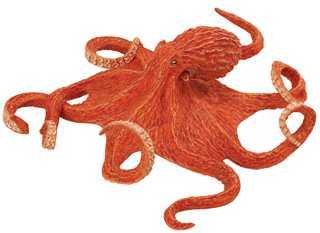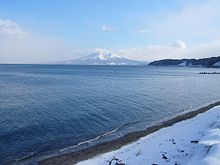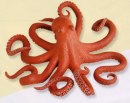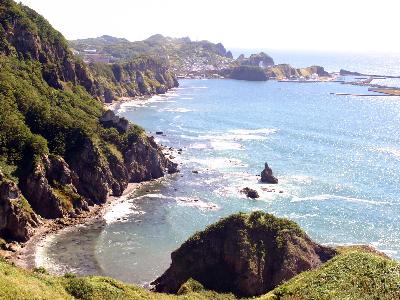Akkorokamui
Posted by: Loren Coleman on January 18th, 2009
The following is a guest blog from Brent Swancer (Mystery Man), writing from Japan. Cryptomundo is appreciative of his contribution, and we think you will enjoy the thought-provoking nature of its overview:

The indigenous Ainu people of Japan have long told of an enormous marine animal known as the Akkorokamui. The creature is said to lurk in Funka Bay, also known as Uchiura Bay or Volcano Bay, which is located in the Southwestern portion of the Northern Japanese island of Hokkaido.

![]()
The bay is ringed on three sides by Oshima peninsula and is surrounded by the volcanoes Mt. Usu and Mt. Komagatake.


The Akkorokamui is said to be an enormous octopus-like or squid-like creature, reaching sizes of up to 110 meters in length. The coloration of the Akkorokamui is said to be a striking red, often described as incandescent and sometimes likened to the color of the reflection of the setting sun upon the water.

Due to this coloration and the creature’s immense size, it is believed that the Akkorokamui is visible from a great distance away. The Ainu people have always feared the Akkorokamui, believing it to have a tendency for swamping boats, and many fishermen were known to carry large sickles aboard their boats in order to protect themselves from the creature.

There have long been alleged sightings made by Ainu, but there are also accounts written of by non Ainu as well. The 19th century Englishman and missionary John Batchelor, who lived among the Ainu and is known for his extensive writings on Ainu life, wrote firsthand a journal entry of an alleged actual incident concerning an apparent Akkorokamui in his book The Ainu and their Folklore.
In the morning, we found the whole village under a cloud. Three men, it was said, were out trying to catch swordfish, when all at once a great sea monster, with large staring eyes, appeared in front of them and proceeded to attack the boat. A desperate fight ensued. The monster was round in shape, and emitted a dark fluid and noxious odor. The three men fled in dismay, not so much indeed for fear, they say, but on account of the dreadful smell. However that may have been, they were so scared that the next morning all three refused to get up and eat; they were lying in their beds pale and trembling.

Another old 19th century account was made by a Japanese fisherman which I [Brent Swancer] have translated from the original Japanese.
And I saw ahead something huge and red undulating under the waves. I at first thought my eyes deceived me and that I was merely seeing the reflection of sun upon the water, but as I approached, I could see that in fact it was an enormous monster, 80 meters in length at least, with large, thick tentacles as big around as a man’s torso. The thing fixed me with a huge, staring eye before sinking out of sight into the depths.

Other eyewitness reports of the creature have surfaced over the years as well. These sorts of reports are all very similar to old sea serpent sightings in the West, which leads me to wonder if there is perhaps some unknown animal lying at the heart of some of these stories. For example, based on descriptions and accounts, it has been speculated that there is perhaps a type of undiscovered, giant octopus in the bay.
Is this what it could be? Although the Akkorokamui is most often thought of as merely part of Ainu folklore, is there a chance that it could be more than that? Could this creature be based in some way on a real, living animal?

[For illustrative purposes, the pink-red octopus images shown are of museum-quality replicas of the North Pacific Giant Octopus (Enteroctopus dofleini). The maps and location photos are specific to the Akkorokamui sighting sites. – Loren]
About Loren Coleman
Loren Coleman is one of the world’s leading cryptozoologists, some say “the” leading living cryptozoologist. Certainly, he is acknowledged as the current living American researcher and writer who has most popularized cryptozoology in the late 20th and early 21st centuries.
Starting his fieldwork and investigations in 1960, after traveling and trekking extensively in pursuit of cryptozoological mysteries, Coleman began writing to share his experiences in 1969. An honorary member of Ivan T. Sanderson’s Society for the Investigation of the Unexplained in the 1970s, Coleman has been bestowed with similar honorary memberships of the North Idaho College Cryptozoology Club in 1983, and in subsequent years, that of the British Columbia Scientific Cryptozoology Club, CryptoSafari International, and other international organizations. He was also a Life Member and Benefactor of the International Society of Cryptozoology (now-defunct).
Loren Coleman’s daily blog, as a member of the Cryptomundo Team, served as an ongoing avenue of communication for the ever-growing body of cryptozoo news from 2005 through 2013. He returned as an infrequent contributor beginning Halloween week of 2015.
Coleman is the founder in 2003, and current director of the International Cryptozoology Museum in Portland, Maine.










Very cool guest essay. I love reading about obscure cryptids.
Brent, thanks for a fascinating report.
I’m quite sure we’re not going to find a cephalopod that is actually 80 or 110m across. It would have trouble gathering enough food as well as controlling its tentacles (given the limited speed of nerve impulses). Still, an octopus larger than known species is hardly impossible. We know giant squid can reach (at a minimum) 18m, whales some 33m, and sauropods over 40m. Being conservative, an octopus with a 15-m span would still be scary and startling enough to account for these reports as well as most of those from the Florida-Cuba-Bermuda zone.
Giant red octopuses are a feature in several kiaju eiga (Japanese giant monster movies.) King Kong vs Godzilla,Frankenstien Conquers the world(seen only in the japanses prints.), and War of the Gargantuas. Art imitating life or life imitating art.
Excellent guest blog, Mystery Man, please do more.
These giant octopi, if not confined to Japan (and I see no reason why they should be, there could easily be something about the underwater topography–note this takes place in VOLCANO bay–which brings the beasties near the surface here), could explain a lot of other sea serpent sightings. Think about it, if the sighting were only of a tentacle as thick as a man’s body, or a portion of such a tentacle, it would look very serpentine, suckers might be mistaken for eyes, folds in the skin for the line of a mouth. Anyway, well worth thinking about. Thanks for bringing this to our attention.
Another excellent entry, Brent. Thanks. Is the akkorokamui the monster depicted in some of the old woodcuts? Some are quite…suggestive, shall we say, but some I seem to recall are more in line with the account by the fisherman and by the 19th century gentleman. The detail about the exudation of ink does seem to indicate a cephalopod of some type (as do the tentacles, of course).
I’m glad people here have enjoyed this piece. It certainly is one of the more obscure cryptids.
MattBille- Yes, I agree that the sizes of 80 to 110 meters are very unlikely. That would be something beyond even the most fanciful estimates for giant squid or octopi. This is one part of the accounts that I think has probably become part of the folklore of the creature, or has been altered. I do think that there is a possibility for much larger octopi than we know of (if not 80 meters), and that through witness exaggeration, these creatures could be misrepresented as being larger than they are. I agree with you in that seeing a very huge octopus on the surface could be shocking enough to produce sightings like the one the Japanese fisherman I mentioned had. It is interesting to speculate on whether there just might be a new type of giant (possibly very huge) octopus in the bay, or one that at least makes it into the bay from time to time. With all of the other animals in Japan with folkloric elements given to them, I wonder just how much of these accounts are based on a real animal and actual biological fact.
Graybear- Yes, I see no reason why they would have to be confined to Japan. There are actually a few old sea serpent sightings that I feel could very well have been caused by very large squid or octopi near the surface. It is interesting that the Akkorokamui is always described as an octopus or squid like creature, though, rather than a serpent. Perhaps, as you said, in this particular bay there is some underwater volcanic effect that causes the creatures to surface more than they normally would, enabling people to get a better look at it. Anyway, I do think it is possible for some sea serpent reports to be attributed to giant cephalopods.
Ceroill- That’s an interesting question. To be honest, I’m not sure the exact connection between the wood cuts and the Akkorokamui. It is something I will have to check out. Yes, the ink is an interesting little detail, isn’t it? It is just another thing that leaves little doubt in my mind that if this animal is real, it is a cephalopod.
Even though I am not a huge fan of marine cryptids, this was an EXCELLENT report from the far reaches. Nice work.
Great blog, Brent. I see no reason why there should not be atype of “Giant Octopus” floating around. If ye olde Giant Squid is known to exist, why not an Octopus? Yeah, I know, “proof”–but at least one can dream, can’t one? 🙂
Excellent article Brent. Closely parallels some of the old stories about the Kraken. I think these people very well may have seen a giant octopus. I agree with you about the size though. When most people are startled, see something they cannot explain or are just plain afraid, whatever it is will seem one-fourth to double its actual size. Still allowing for such “Kentucky windage” that is an awfully big mollusk.
Yes, a couple of the old pictures of “sea monster” encounters definitely show a creature that is closer than the octopus than the squid (cam’t remember if it was Pliny or someone else’s work where that first showed itself).
And there is also the elusive/controversial St. Augustine monster that washed up and was initially tagged as octopus flesh.
Really it could be that huge, what do we really know of the ocean and all that dwells with in it… Not a damn thing! The fact that it lives in a volcanic area just adds to it, maybe it thrives in those conditions or strange nutrients from deep within the earth(Food of the Gods?) made it huge and mean. Lets face it a world without monsters or as the heavy metal rockband Metallica put it one of my favorite songs “as you prepare to face the thing the thing that should not be” would be dull and boring.
Thanks Mystery Man;
Very enlightening and even thought provoking, for me, at least in regards to sea creatures. Exaggerations or not, it is true that the most productive ocean is capable of sustaining the most prodigeous animal life by any and every description and dimension. There in the North Pacific is the planet’s most productive ocean region due to the characteristics of its large size and basin like shape, with deep currents travelling along the upward sloping continental margins and creating deep upwellings of nutrients and oxygen which along with the 6 months of siginificant sunlight (the seasonal tilting of the axis giving the higher latitudes their characteristic long day/night periods) turning the ocean into a soup of plankton so rich with life that it supports gazillions of animals orders of magnitude greater that what the land does, some types of which are the largest in the world (whales). I’m not surprised by the rareness of sightings of cryptic things like giant 300 foot long cephalopod or 80 foot crustacean or boat sized sea cucumber or mile-long ctenophore, that live deep and widely dispersed in the Ocean. Even when creatures are seen on or from the surface, our vision is not designed to make accurate descriptions of what we see in the proximity of water with it’s propensity to distort light especially when it can heave and bend. And more significantly, these days the wild stocks of sea creatures are far more heavily impacted and their previously unimaginable numbers have been mostly eliminated (Cod in the North Atlantic and Whales in the Pacific) by our large scale harvesting practices and other human impacts, historic and curret, and that alone explains the current scarcity of really large sea animals. We are just now discovering and appreciating that some ceatures of the cold dark waters are sometimes blessed with longer lives that we terrestrials typically have and think of as normal. Right whales living to well over 200 years! We don’t ususally appreciate that the fish in our fishsticks might have been alive for 60 years or more and in no way showing signs of aging, before getting scraped off the bottom of the Bering Sea and being processed into deep fried patties. Their size suggests that for some species their growth is almost indeterminate. Why not a 300 foot long squid…it’s not like there isn’t enough food and gravity’s not the problem like it is up-above on dry-land. I’m sure there are physiological limits even to creatures with indeterminate growth, like gas solubilities and mass inertial/tissue strength coefficients, so I’m not suggesting “godizilla-like” gargantuan-sized monsters, but in the cold rich bottoms of the oceans and deep canyons with their upwelling or concentrated nutrients are conditions that we don’t experience very directly, and when it comes to the our trying to imagine what the ocean hides by its size and conditions, we are ususally staggered by the reality…cities of smoking mineral rich vents, mountains of frozen methane containing more energy than all our current oil reserves, voclanoes and trenches and submarine storms that distribute energies unlike anthing we experience in terrestrial conditions we see.
Imagine one of these things emerging from a lovecraftian larval estevation/incubaton period in that stygian darkness, signaled or disturbed by some long cycle phenomenon, like a thousand year storm or a submarine avalanche, stirring up old but dependable environmental cues, hungry and lookin’ to party.
Awesome post, hope we hear more about this in the future.
Didn’t Godzilla fight this beast?
I agree the size reports are ludicrous, this is likely huge size over estimations on sightings of giant squid.
Could these even be known large cephalopods, and this is where they lay and brood their eggs?
Some great thoughts! Especially regarding long life cycles and stalled larval/incubation/developmental periods. Never thought about it before but its certainly plausible. It makes biological sense for large animals to wait for certain cues to prompt birth or metamorphosis into an adult reproductive form until conditions are apt. Perhaps a glut of food, increased sea temps or a regular current switch phenomenon like el Niño, even polar switches!. These dormant periods would explain rarity in sightings. If small inverts (e.g. Triops eggs can stay lay dormant as an egg up to 20 years when dry and hatch when re wetted) marsupials and fish can delay reproduction and or have latent or static periods of development then why not large cephalopods etc. I love that idea!
The second report sounds like it could even be discribing a giant pelagic jellyfish – the huge tentacles discribed sound sort of like that massive tangle emanating from beneath the center of such critters. It would be hard to tell the exact size of something reasonably large if it was deep enough. Then again there’s the remote possibility that there is an 80 meter octopus if it spent most of its time dwelling on the bottom waiting for plankton to flow into it. It may not have speedy control of its tentacles as MattBille mentioned, but it may not need such if it spent 90% of its time lying around. Agreed, of course, it’s still not likely to reach quite that size
110? don’t know how big that is.. what feet is that?
i believe it. 🙂
who knows how deep the water goes, so there is enough Giant creatures being able to live down there… sure it seems to huge, but who knows.. there could be a 150ft creature there.. look at the blue whale 110ft is large… a larger one is capable of living
besides…. they probably move around so we can’t find them, and the fact that it’s not really been seen is cause, it’s a underwater dweller, that only dwells in the ocean’s deep. so not all fishes will be known right? right..
but i do believe on day, we will see all the creatures in existance. maybe not scientist. but Humans that is…
at least one see’s one that’s what matters. right?
besides, we have 2 b Paitient.
it will surface
let’s find out if there would be any expeditions?
this creature doesn’t appeal to me, but now it does.. especially octopuss squid like… which means, it’s not really known…. it could be a hybrid of unknown types or known types or known and unknown types.
ya know what.. I think that’s what it is…. unless it’s a new type that doesnt relate to any of them, that looks like them.. for example.> Fishes.. not all of them can mate, but they have fins.
lol i’d be thrilled if it was a jellyfish.
this reminds me of the levaithan from the bible..
although the leviathan was talked about like if it was a reptile but hey fishes have scales too right?
i could imagine a scaled octopus that breathes fire…
remember that bettle that makes fire?? i forgot it’s name, but it’s possible…. have you noticed that each animal has it’s specialties?
for example:
swimming birds
flying birds
non flying birds
burrowing birds
mimicing birds
Carnivorus birds
Giant Birds
Crowing Birds
Toothed Birds..
long necked bird
why not a
Non firebreathing Octopus
Firebreathing Octopus
scaly octopus
scaley and firebreathing octopus
how about
squirles
flying squirles (leaping that is)
you get the picture…
i’d be laughing if there was a firebreathing squirle lol.
anyways we can not debunk that, cause you and i know that there’s been new species found right? right. including living fossils. and new Hybrids.
we can not say we know all things.
i do hope one day these cryptids and unkowns and new hybrids do become common as pets..
in my city. dogs and cats are common, now.. rabbits are taking over my street… wild rabbits….. lol
what if wild skunkapes become normal in streets? like rabbits? and dogs and cats?
Godzilla never fought the octopus. Only King Kong, Frankenstein and the Green Gargantua. The real life octopus in King Kong vs. Godzilla reportedly became SFX Director Eiji Tsuburaya’s dinner after the shoot!
Ranatemporia- Yes, it is quite an amazing idea isn’t it? Dogu4 has mentioned it here before and I find it to be an intriguing line of questioning.
Dogu4- I think your ideas are very interesting, and I don’t see how they could at all be biologically improbable. It sounds like a plausible scenario to me. I really enjoy hearing these unique takes on what might be going on with this cryptid, so thank you for sharing. It really gets me to thinking about just how large a cephalopod could get, especially one with a life cycle as you described. Surely, it is possible for squid and octopi to get larger than the current record holders.
Considering the relative freedom from the effects of gravity, the tendency for these types of creatures to reach already large sizes, and the amazing amount of biomass in the oceans to support such a creature, I’m sure that we might possibly turn up cephalopods quite a bit larger than we know of now. 110 meters seems extreme, but I’m sure they certainly reach very huge sizes.
Anyway, I really like your ideas here. It’s a fascinating concept, and at the very least would make a great movie! 🙂
Lightning Orb- Yes, a jellyfish seems like it might match with some accounts, but the thing about that report that tends to rule that out for me is the clear mention of the giant eye. Not only do jellyfish not have eyes, but the fact that giant squid are known for their proportionately large eyes makes me think that the Japanese fisherman’s report was of a cephalopod.
I also, like some other here, can’t help think that the volcanic activity of the area has some part to play in the case of the Akkorokamui.
For instance, it could be a reason for such an enormous, deep dwelling denizen to rise to the surface in the first place. It is thought that warm water currents can affect a giant squid’s buoyancy mechanism, causing them to rise to the surface where they may not always be able to get down again. To compound the problem, the blood of giant squids has been found to not carry oxygen as well at higher temperatures, which means it runs the risk of suffocating if it cannot make its way back down to the cold depths. A good many giant squid carcasses have been found in areas where a cold water ocean stream and a warm water stream meet, suggesting that sudden warm water may be responsible for bringing the creatures up from the depths where they are in turn seen by humans. Perhaps in the case of the Akkorokamui, a sudden warm water current could be caused by volcanic activity on the ocean floor, which in turn brings them to the surface.
Another effect that undersea volcanic activity might have is providing a stream of upwelling nutrients to support an octopi or squid reaching huge sizes. These vents could also attract communities of other creatures that could add to the food resources available to the Akkorokamui.
The volcanic activity could even be the stimulus that disturbs the “lovecraftian incubation period,” of an enormous, dormant animal, that Dogu4 so eloquently wrote of above in his post.
Whatever the effects are in this case, the fact that there is so much volcanic activity in the area where this animal is known to inhabit makes me think that it is more than a coincidence. It seems very likely there is a connection.
Just chipping in some of the possible spiritual aspects that might put this cryptid into better perspective.
“Kamuy” (also spelled “Kamui”. In Japanese it’s written as かむい) are divine or spiritual beings in Ainu mythology. The word “kamuy” has been translated as meaning “god” due to its closeness to the Japanese kami ( かみ or in kanji 神.)
Kamuy are often the protagonists of an Ainu oral tradition of telling stories of the journeys of heroes or gods called “Kamuy Yukar.” Judging by part of its name, this cryptid seems to have gotten its start in a more spiritual light. My resources indicate it’s not a god, maybe a spirit practicing Darwinism?
I couldn’t find a translation of the “akkoro” part of Akkorokamui. I’ll keep looking.